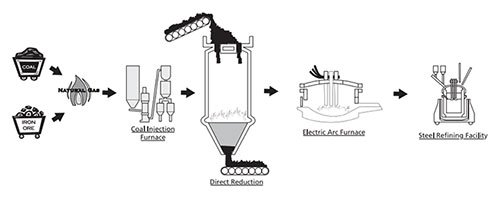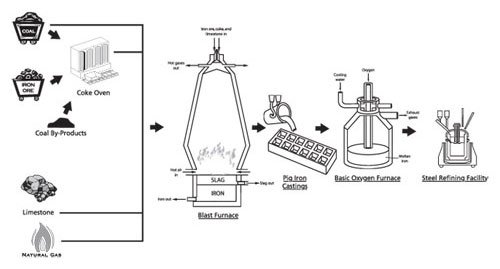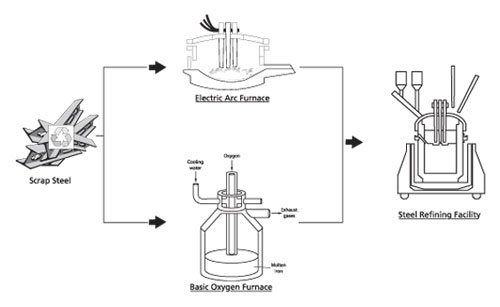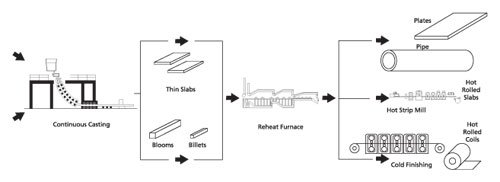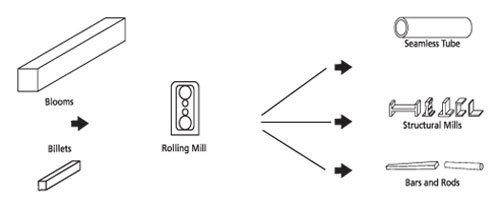The Basics of Steelmaking
To gain a full understanding of the performance capabilities of many of the parts offered by Huyett - specifically pins, keystock, and machine keys - it is important to have a firm understanding of the different methods used in the manufacture of steel as well as the various finishing options and how different types of steel (including chemical composition), heat treating, and plating affect the strength, tolerance, and hardness.
The following is a brief introduction to several methods of steel production and common finishing practices. Visit the links on the right to learn more about steel making, how steel is analyzed, and technical information related to steel making.
Steelmaking: Direct Reduction Method
Iron is not a free element on Earth but is trapped in the Earth's crust in its oxide state. Iron ore is a mineral containing enough iron to be a commercially viable source of the element to be used in steelmaking.
Steel is the generic term for a large family of iron - carbon alloys, which are malleable, within some temperature range, immediately after solidification from the molten state. The principal raw materials used in steelmaking are iron ore, coal, and limestone. These materials are converted in a blast furnace into a product known as "pig iron," which contains considerable amounts of carbon (above 1.5%), manganese, sulfur, phosphorus, and silicon. Pig iron is hard, brittle, and unsuitable for direct processing into wrought forms. Pig iron was named long ago when molten iron was poured through a trench in the ground to flow into shallow earthen holes. The arrangement looked like newborn pigs suckling. The central channel became known as the "sow," and the molds were "pigs."
Steelmaking: Using Pig Iron
Coke is a processed form of coal that is used as the fuel in a blast furnace because it burns evenly inside and out and is not crushed by the weight of the iron ore.
Steelmaking is the process of refining pig iron as well as iron and steel scrap by removing undesirable elements from the melt and then adding desirable elements in predetermined amounts. A primary reaction in most steelmaking is the combination of carbon with oxygen to form a gas. If dissolved oxygen is not removed from the melt prior to or during pouring, the gaseous products continue to evolve during solidification. If the steel is strongly deoxidized by the addition of deoxidizing elements, no gas is evolved, and the steel is called "killed" because it lies quietly in the molds. Increasing degrees of gas evolution (decreased deoxidation) characterize steels called "semikilled," "capped," or "rimmed." The degree of deoxidation affects some of the properties of the steel. In addition to oxygen, liquid steel contains measurable amounts of dissolved hydrogen and nitrogen. For some critical steel applications, special deoxidation practices as well as vacuum treatments may be used to reduce and control dissolved gases.
Steelmaking: Using Scrap
Scrap steel is ferrous, or iron-containing material, that is remelted and recast into new steel. Recycling scrap steel accounts for up to 25% of oxygen furnace charge and up to 100% of the raw material for electric furnaces.
The carbon content of common steel grades ranges from a few hundredths of a percent to about 1%. All steels also contain varying amounts of other elements, principally manganese, which acts as a deoxidizer and facilitates hot working. Silicon, phosphorus, and sulfur are also always present, if only in trace amounts. Other elements may be present, either as residuals that are not intentionally added, but result from the raw materials or steelmaking practice, or as alloying elements added to effect changes in the properties of the steel. When reviewing a steel chemical certification, remember that iron is the element that composes the majority of the chemical values listed. (
Download Certificate of Analysis)
Steels can be cast to shape, or the cast ingot or strand can be reheated and hot worked by rolling, forging, extrusion, or other processes into a wrought mill shape. Wrought steels are the most widely used of engineering materials, offering a multitude of forms, finishes, strengths, and usable temperature ranges. No other material offers comparable versatility for product design.
Steel Finishing: Hot Working
The hot mill squeezes slabs which are the most common type of semi-finished steel. Traditional slabs measure 10 inches thick and 30-85 inches wide (an average about 20 feet long), while the output of the recently developed "thin slab" casters is approximately two inches thick. Subsequent to casting, slabs are sent to the hot-strip mill to be rolled into coiled sheet and plate products.
Following hot working, steel goes through a "pickling" process. Pickling is a chemical process whereby steel is run through a progressive series of tanks. Chemicals in the tanks remove oxidation and impurities from the surface of the product. Hydrochloric acid is a common chemical compound used in pickling.
Steel Finishing: Cold Working
Finished steel, typical of the grades used in Huyett's manufacturing, are cold rolled (or cold drawn) after being pickled. Cold finishing, as the process is generally referred to, involves running the hot rolled pickled and oiled product through a series of progressive dies or rollers at room temperature. The effect of such work stretches the steel, which creates a permanent increase in the hardness, strength, and finish of the product.
Mill Formed Steel
The rolling mill uses dies, or progressive sets of dies, to create shapes or final-dimensioned sizes. Keystock steel, or bright steel, possesses the finest shapes and sizes. Bars are typically bead-blasted following rolling to increase brightness and surface perfection.
Cold finished steel is typically ready to be used for manufacturing finished goods, but in some cases, additional processes are performed. For Huyett keystock, bars are bead blasted to create a "bright steel" that is free of surface imperfections that could cause problems when inserted in a keyway.
Other grades such as Blue Tempered (also known as "Blue Clock"), which is used to manufacture shims, are heat treated and ground to finer tolerances and hardened finishes.
Steel must be handled carefully after manufacturing so that straightness tolerances are maintained and surface imperfections are not created. Proper storage from the elements must be used (including when shipping on a truck) to minimize corrosion. Finally, steel must be handled carefully during loading and unloading so that bars are not bent, warped, or "pinged" on the sides. Particularly for keystock, it is important that edges be sharp, straight, and true to ease installation into the keyway.

